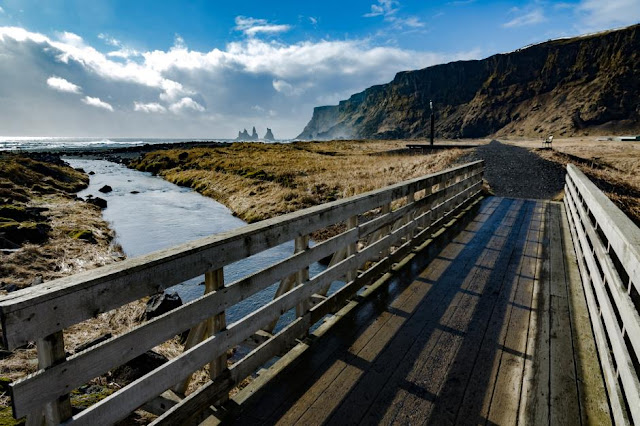Iceland is an increasingly popular destination for short trips and long adventures alike. It’s no surprise: there's dramatic scenery, incredible wildlife and it's close to both Europe and the USA. With a surge in tourism in recent years, some of its top attractions can be extremely busy. But there's more to Iceland than the famous Golden Circle – the loop of the popular sites around Reykjavík that explores Geysir, Thingvellir National Park and Gulfoss waterfall – so here's where to go in Iceland when you've seen the big sights.
You may also like:
- To Iceland, 'pain wallet' because of Europe's most expensive spending
- Fancifully beautiful black sand beach no one is allowed to bathe in Iceland
Mývatn Lake
You can find evidence of Myvatn’s volcanic past by exploring the Dimmuborgir lava formations (pictured), a series of small mossy canyons. These are the home of Iceland’s infamous 13 Yule Lads, the Christmas pranksters who supposedly visit children to leave gifts or rotten potatoes. A little further northeast (follow the signposts from Myvatn) is the Krafla area, one of Iceland's most active volcanic areas where the lava is still steaming hot after its last eruption in 1984.
End your visit to the lake area by taking a dip in Mývatn Naturebaths (pictured) – the Blue Lagoon of northern Iceland. The thermal pools here are blue with silica and are a toasty 40°C. Grab a beer and float over to the edge of the pool where you’ll get impressive views over Mývatn lake and the surrounding landscape.
Seljavallalaug pool
Dettifoss
Dettifoss is reportedly the most voluminous waterfall in Europe, as 1,000 litres of water per second plunge over its rocky edge. The landscape around is stark and bleak, so the cascading veils of water crashing down the rocky canyon seem even more impressive.Dettifoss is reportedly the most voluminous waterfall in Europe, as 1,000 litres of water per second plunge over its rocky edge. The landscape around is stark and bleak, so the cascading veils of water crashing down the rocky canyon seem even more impressive.The surrounding landscape is loved by hikers for the impressive geological anomalies that line its cliffs, such as the Whispering Rocks of Hljoðaklettar and the footprint of Norse god Odin's horse in the Ásbyrgi canyon.Vík í Mýrdal
The southernmost settlement on Iceland’s main island, Vík is one of the most attractive towns in the country. Surrounded by dramatic cliffs, and home of the famous black basalt beach, it’s easy to fall in love with this tiny town of 300 inhabitants.Walk to the top of Reynisfjall (pictured), the largest cliff to the east of the village, and you’ll get impressive views of Reynisdrangar, basalt sea stacks shooting out of the sea just off the coast. Look northwards and you’ll be treated to a view of the impressive Mýrdalsjökull glacier.
Vík is a great jumping off point to explore some of Iceland’s most Instagram-famous spots: Skógafoss waterfall with its mystical rainbows and the abandoned DC plane (pictured) on the black beach at Sólheimasandur.
Húsavík
According to the Book of Settlement – a medieval document that describes how people came to Iceland – Húsavík was the first place settled by the Norse when they arrived in 870 AD. The pretty fishing village is mainly known for the many whales that live in the surrounding waters.
Húsavík is recognised as one of the best places in the world for whale watching. There are 23 species in Icelandic waters, but the most common to Húsavík and the surrounding waters are Humpback, Minke and Blue whales. Boat excursions to spot these magnificent creatures are available daily from the town harbour.It's all about the whales in this part of the country, so while you're here take time to visit the Whale Museum. It's a small but fascinating exhibition with the skeletons of ten different species of whales that inhabit the waters around Húsavík. The highlight is the Narwhal specimen with its unicorn-like horn protruding from its skull. The museum is dedicated to the preservation of whales, and has even received a UN award for environmental tourism.Secret Lagoon
The Blue Lagoon is one of Iceland’s most famous postcards, but the prohibitive price tag and popularity of the geothermal baths has led more adventurous travellers to look for alternatives like the Secret Lagoon. It’s easily accessible from Reykjavík, in the small town of Flúðir (that also boasts a surprisingly fun tomato farm). Built as a public swimming pool in 1947, the lagoon is heated by bubbling hot springs nearby which you can wander around – just don’t fall in as temperatures exceed 100°C.The pool isn’t huge, but the crumbling ruins of the old changing rooms shrouded in the steam rising from the hot spring makes the Secret Lagoon a surreal place. There is a small geyser that feeds into the main pool that erupts every few minutes.
It’s far more affordable than other lagoons around Iceland, and there’s a nice bar and restaurant area too. Go early in the morning or later in the evening to beat the crowds.
It’s far more affordable than other lagoons around Iceland, and there’s a nice bar and restaurant area too. Go early in the morning or later in the evening to beat the crowds.
Egilsstaðir
Egilsstaðir is a good base from which to explore eastern Iceland. It’s a charming little town on the banks of the Lagarffljot river. According to legend a huge beast known as Lagarfljótsormur inhabits the river, and is something of a local celebrity akin to the Loch Ness Monster in Scotland.Though the town itself is fairly modest, the region around Egilsstaðir is a favourite with hikers, who come here to explore the many waterfalls, lakes, creeks and canyons, as well as the stunning vistas from the mountaintops. Don’t miss Laugarvalladalur valley (pictured), which is full of hot springs perfect for bathing and even has a warm waterfall.Eastern Iceland offers some of the most breathtaking coastlines in the whole island, so visitors to Egilsstadir will want to travel towards the sea to experience places like Stapavík – an ancient harbour where visitors can hike around the ruins of 15th-century fishing villages. Nearby is Stórurð – a collection of giant boulders and teal ponds just below a small glacier on the Dyrfjoll mountains.Hornstrandir Nature Reserve
The crowning jewels of the Westfjords, Hornstrandir Nature Reserve is a huge area in the northwest of Iceland where green fertile slopes rise into sharp cliffs that crash 1,600 feet down into the Atlantic. Only 14% of visitors who come to Iceland go to the Westfjords, so if you are after an adventure away from the crowds, look no further.Throughout the park you can spot houses carved out of the moors, used by the original settlers of the peninsula (think Hobbit holes with grassy roofs) as well as the old farmsteads, abandoned in the 1950s. This area is also home to seals, who perch on the rocks and beaches, as well as over 30 species of birds and wild Arctic foxes (pictured).
Hornstrandir is completely isolated – there are no villages or even roads. Most people visit here with a guide, but it is possible to travel solo. It's a seriously back-to-nature experience and you're unlikely to see any other people in the reserve on your hike.







































0 coment rios: